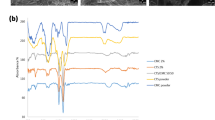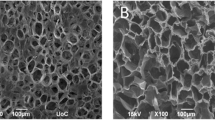Abstract
Stem cell-based tissue engineering holds much hope for the development of multifunctional tissues to replace diseased organs. The attachment and survival of stem cells on a three-dimensional (3D) scaffold must be enhanced for faster progression of stem cell based tissue engineering. This study evaluate the stability of mesenchymal stem cells (MSCs) in 3D porous scaffolds composed of a collagen and chitosan blend impregnated with epidermal growth factor incorporated chitosan nanoparticles (EGF-CNP). The EGF-CNP scaffolds were characterized by transmission electron microscopy, which revealed that the nanoparticles were round in shape and 20 ∼ 50 nm in size. The scaffolds were prepared by freeze drying. A Fourier-transform infrared spectrum study revealed that the linkage between collagen and chitosan was through an ionic interaction. Thermal analysis and degradation studies showed that the scaffold could be used in tissue engineering application. MSCs proliferated well in the EGF-CNP impregnated scaffold. A scanning electron microscope study showed anchored and elongated MSCs on the EGF-CNP impregnated scaffold. A 3D biodegradable collagen chitosan scaffold impregnated with EGF-CNP is a promising transportable candidate for MSC-based tissue engineering, and this scaffold could be used as an in vitro model for subsequent clinical applications.
Similar content being viewed by others
References
Perry, T. E., S. Kaushal, F. W. H. Sutherland, K. J. Guleserian, J. Bischoff, M. Sacks, and J. E Mayer (2003) Bone marrow as a cell source for tissue engineering heart valves. Ann. Thorac Surg. 75: 761–767.
Kuo, T. K., S. P. Hung, C. H. Chuang, C. T. Chen, Y. R. Shih, S. C. Fang, V. W. Yang, and O. K Lee (2008) Stem cell therapy for liver disease: Parameters governing the success of using bone marrow mesenchymal stem cells. Gastroenterol. 134: 2111–2121.
Cuomo, A. V., M. Virk, F. Petrigliano, E. F. Morgan, and J. R. Lieberman (2009) Mesenchymal stem cell concentration and bone repair: Potential pitfalls from bench to bedside. J. Bone Joint Surg. Am. 91: 1073–1083.
Tamama, K., V. H. Fan, L. G. Griffith, H. C Blair, and A. Wells (2006) Epidermal growth factor as a candidate for ex vivo expansion of bone marrow-derived mesenchymal stem cells. Stem cells 24: 686–695.
Moreau, J. E., J. Chen, R. L. Horan, D. L. Kaplan, and G. H. Altman (2005) Sequential growth factor application in bone marrow stromal cell ligament engineering. Tissue Eng. 11: 1887–1897.
Johnstone, B., T. M. Hering, A. I. Caplan, V. M. Goldberg, and J. U. Yoo (1996) In vitro chondrogenesis of bone marrow-derived mesenchymal progenitor cells. Exp. Cell Res. 238: 265–272.
Peng, L., X. R. Cheng, J. W. Wang, D. X. Xu and G. Wang (2006) Preparation and evaluation of porous chitosan/collagen scaffolds for periodontal tissue engineering. J. Bioact. Comp. Polym. 21: 207–220.
Salvay, D. M and L. D. Shea (2006) Inductive tissue engineering with protein and DNA-releasing scaffolds. Mol. Biosyst. 2: 36–48.
Zhang, Y., X. Cheng, J. Wang, Y. Wang, B. Shi, C. Huang, X. Yang, and T. Liu (2006) Novel chitosan/collagen scaffold containing transforming growth factor-beta1 DNA for periodontal tissue engineering. Biochem. Biophys. Res. Commun. 344: 362–369.
Simmons, C. A., E. Alsberg, S. Hsiong, W. J. Kim, and D. J. Moone (2004) Dual growth factor delivery and controlled scaffold degradation enhance in vivo bone formation by transplanted bone marrow stromal cell. Bone 35: 562–569.
Langer, R. and J. P. Vacanti (1993) Tissue engineering. Science 260: 920–926.
Agarwal, C. M. and R. B. Ray (2001) Biodegradable polymeric scaffolds for musculoskeletal tissue engineering. J. Biomed. Mater. Res. 55: 141–150.
Pan, Y., Y. Li, J. Zheng, H. Xu, G. Wei, J. Hao, and F. Cui (2002) Bioadhesive polysaccharide in protein delivery system: Chitosan nanoparticles improve intestinal absorption of insulin in vivo. Int. J. Pharm. 249: 139–147.
Hwang, N. S., S. Varghese, and J. Elisseeff (2008) Controlled differentiation of stem cells. Adv. Drug Deliv. Rev. 60: 199–214.
Hwang, N. S., M. S. Kim, S. Sampattavanich, J. H. Baek, Z. Zhang, and J. Elisseeff (2006) Effects of three-dimensional culture and growth factors on the chondrogenic differentiation of murine embryonic stem cells. Stem cells 24: 284–291.
Moreau, J. E., J. Chen, R. L. Horan, D. L. Kaplan, and G. H. Altman (2005) Sequential growth factor application in bone marrow stromal cell ligament engineering. Tissue Eng. 11: 1887–1897.
Kamal, A., I. Ahmed, J. Kamal, J. N. Babu, M. Schindler, and S. Meiners (2008) Covalently attached FGF-2 to three-dimensional polyamide nanofibrillar surfaces demonstrates enhanced biological stability and activity. Mol. Cell Biochem. 309: 157–166.
Tan, W., R. Krishnaraj, and T. A. Desai (2001) Evaluation of nanostructured composite collagen-chitosan matrices for tissue engineering. Tissue Eng. 7: 203–213.
Wang, X., Y. Yan, Z. Xiong, F. Lin, R. Wu, R. Zhang, and Q. Lu (2005) Preparation and evaluation of ammonia-treated collagen/chitosan matrices for liver tissue engineering. J. Biomed. Mater. Res. Part: B Appl. Biomater. 75: 91–98.
Yao, C., D. Storey, and T. J. Webster (2007) Nanostructured metal coatings on polymers increase osteoblast attachment. Int. J. Nanomed. 2: 487–492.
Taravel, M. N. and A. Domard (1993) Relation between the physicochemical characteristics of collagen and its interaction with chitosan. Biomater. 14: 930–938.
Fan, V. H., A. Au, K. Tamama, R. Litterll, L. B. Richardson, J. W. Wright, A. Wells, and L. G. Griffith (2007) Tethered epidermal growth factor provides a survival advantage to mesenchymal stem cells. Stem cells 25: 1241–1251.
Cetin, M., Y. Aktas, I. Vural, and Y. Capan (2007) Preparation and in vitro evaluation of bFGF-loaded chitosan nanoparticles. Drug Deliv. 14: 525–529.
Bhattacharya, S., R. M. Ray, and L. R. Johnson (2007) EGFR plays a pivotal role in the regulation of apoptosis in intestinal epithelial cells. FASEB J. 21: 925.
Author information
Authors and Affiliations
Corresponding author
Rights and permissions
About this article
Cite this article
Pulavendran, S., Thiyagarajan, G. Three-dimensional scaffold containing EGF incorporated biodegradable polymeric nanoparticles for stem cell based tissue engineering applications. Biotechnol Bioproc E 16, 393–399 (2011). https://doi.org/10.1007/s12257-009-3155-4
Received:
Revised:
Accepted:
Published:
Issue Date:
DOI: https://doi.org/10.1007/s12257-009-3155-4




